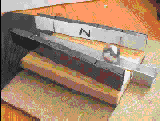 S.M.O.T
Version 1.0
S.M.O.T
Version 1.0 S.M.O.T
Version 1.0
S.M.O.T
Version 1.0
created on 23 May 1997 - drawing by Jean-Louis Naudin
Last update 28 May 1997
CONSTRUCTION TIPS :
Make magnet spacing adjustment holes (for the straight pins) in the balsa base every 0.5mm from the ALUM "U" channel. Alternate them up and down by 0.5 mm. This helps to reduce the balse becoming totally destroyed by too many pin holes and aids returning to the same adjustment that worked before. Normally adjustments in 0.5mm increments are fine enough.
The Alum "U" channel is NOT fixed to the balsa base. The balse side supports hold it firmly but still allow it to be moved for adjustment or removed for polishing, ect.
"Polish" the side rails with a "HARD" lead pencil rubbed on the supporting edges used by the ball until you can feel no bumps. Leave the graphite on the edges. It really helps to reduce frtictional losses. Remember "NOISE" is energy lost.
The side magnet assys are made up of small 4x10x13mm ceramic fridge magnets. They are superglued togther. The 3x10x104mm steel bar serves as a support for building and helps to even out the magnetic graduations in the ramp. The steel bar should be outside the ramp. If placed on the inside, the field will be weakened as the soft domains will allow the magnets field to return to the other pole too easily. Treat the magnet assys with care, the combined strength is quite high and the assys will suck to each other over quite a distance and as the ferrite material is brittle, you could easily break your magnets.
ADJUSTMENTS :
RAMP and BALSA SUPPORT BASE :
The bend in the 12mm Alum "U" channel should be adjusted for a 12mm clearance from the underside of the end of the ramp. In otherwords, the entry section of another ramp should just fit under the exit of the preceeding. Thats what the notch in the lower balse base piece is for.
Once the bend angle is done and the rolling surfaces are polished, fit the channel into the balsa base and slide it up and down until the 20mm section just touches the level table or whatver you are sitting it on. Check that the bottom of the ramp just clears a spare section of channel. If not, sand or otherwise adjust the height of the end of the ramp supports. Now go back and recheck the 20mm section is still on the table. Mark a line on the bottom of the channel inline with the bottom edge of the balsa support base for future reference.
It is very important for the end cut off of the ramp to be clean and at right angles to the ramp. It is the exit rails that the ball will use to exit. If the cut is off, the ball on exit will be thrown to one side or the other and a clean exit will be very hard to achieve.
MAGNET POSITINING :
Top magnet spacing (measured from the inside of the Alum "U" channel (1.5mm wall thickness) is approx 6mm, bottom spacing is approx 10mm.
The bottom egde of the magnet assys are in line with the start of the ramp (the hacksaw cut). These spacing will vary with the strength of the magnets you use.
As the ball rolls up the ramp, it will "Hit" a end wall. This wall is magnetic and is produces by the quick reduction in the field strength that occurs at the end of the magnet assys. If you slide the magnets down the ramp and release a ball on the 20mm start platform, you should see the ball climb the ramp and then, as it nears the end, quickly be thrown back down the ramp. What you must now do is to slowly move the magnet assys up the ramp until this bounce back point is just over the exit point. If you move the magnets too far up. the ball will be pulled off the end rails and be pulled onto one of the side magnets. There is a balance point where the ball drops over the end and rolls down the end rails, but is gently forced back onto the end rails as it falls.
MAGNET VERTICAL POSITIONING :
It is IMPORTANT that the vertical centre of the magnet arrays is ABOVE the centre of the steel ball. This helps to reduce rolling friction. Care must be observed as too high a magnet position and the ball will be sucked off the track by any unbalances side to side magnetic forces. I use paper to shim the side magnet assys up and down. The better the side to side balance, the higher the magnets can be moved and the better the whole thing works.
GETTING THE BEST RESULTS :
Once you have mastered the initial adjustments and can get the ball to climb and drop out every time, you are now into the fun part. BUT first, mark or otherwise record the current settings. Try varying the magnet positioning (top & bottom spacing, position up and down the ramp and vertical centre to centre) to margin your ramp. Vary all the adjustemnts to find the edges where the effect stops. Try this on all the adjustments until you can set the adjustments to optimal (IE in the middle).
This margining is necessary to gain a good understanding of ramp characteristics as we will need to vary some of the adjustments when we get into linking 4 or more ramps in Phase 2.
This margining is necessary to gain a good understanding of ramp characteristics as we will need to vary some of the adjustments when we get into linking 4 or more ramps in Phase 2.
Meanwhile enjoy, experiment and record your results. Please feel free to discuss your problems. If you can post photos, so much the better.
Over to you.
![]() Email to Greg
Watson : gwatson@microtronics.com.au
Email to Greg
Watson : gwatson@microtronics.com.au
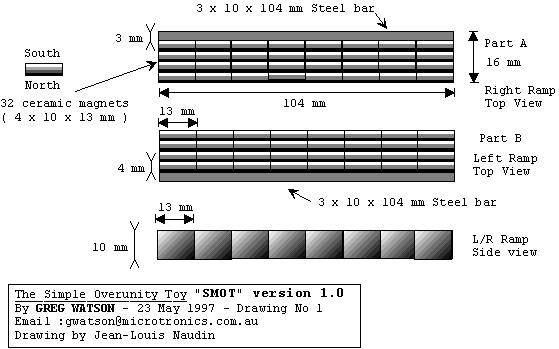
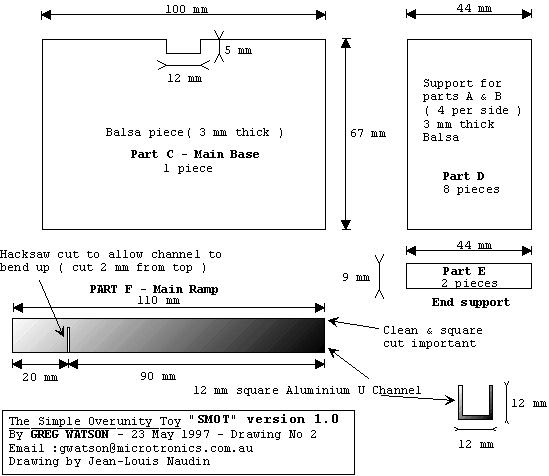
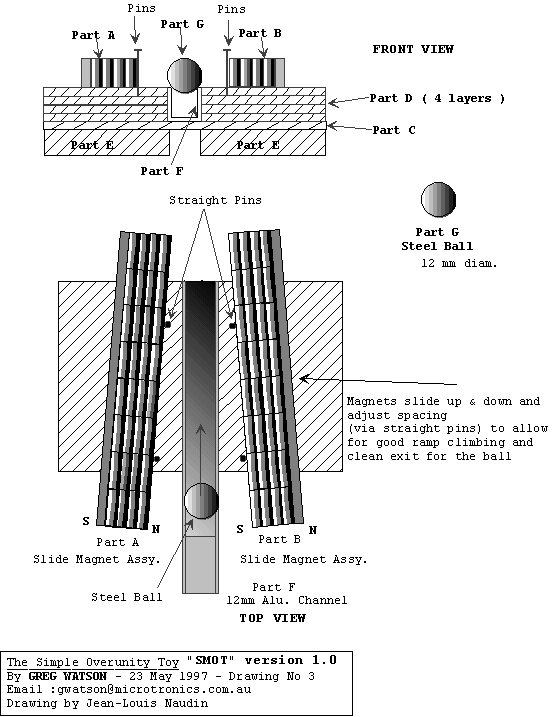
Here it a complete list for the SMOT Phase 1 device :
1) 64 x 13x10x4mm Ceramic Magnets (fridge type),
2) 1 x 100x267x3mm Balsa Sheet,
3) 1 x 110x12x12mm Alum "U" channel, (length to be 13-15mm shorter than magnet arrays),
4) 1 x 12mm dia Steel ball bearing (chrome plated), (More to play drop the ball)
5) 2 x 3x10x104mm Steel Backing Plates,
6) 1 x Balsa Knife,
7) 1 x Hacksaw,
8) 1 x Sheet Sandpaper (Medium grit),
9) 1 x 3ml Tube Superglue,
10) 4 x Straight Pins,
11) 1 x Ruler (To mark out mag array adjustment pin holes),
12) 1 x Small Flat Metal File,
That should about do it.
IMPORTANT NOTES from Greg Watson :
" I thought I should comment here on the selection of magnets to build up the side arrays.
The height of the magnets MUST be less than the lift otherwise you will not be able to get the ramps to link.
My design is based on a 12mm lift as this is the height of the Alum "U" channel. My magnet height is 10mm and therefore the magnet arrays from two linking ramps can fit one under the other.
Look at the picture bellow showing why this is important.
The SMOT ramp design did not just happen. Be carefull to change it too much. There are elements in the design which are based on MUCH pain and experience. I decided to use small magnets to build up the magnet arrays as this was the only way I could see to easily obtain the magnet array shape that I needed, very wide, long and low. Magnets like that are not easy to find in one block. Try to keep to the 104mm magnet array length as the 90mm ramp length is based on this.
I encourage you to experiment, but first build a unit like the plans and then try your own design. Just remember, whatever you build, you must be able to link 3-4 units in Phase 2. "
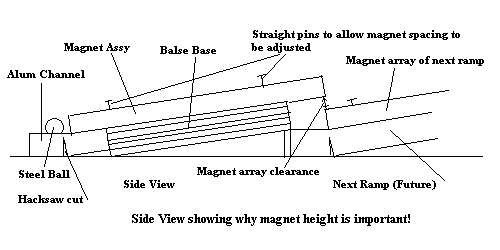
Look at the SMOT's Magnetic field density simulation and calculation
Today, I have built and tested SUCCESSFULLY this Greg Watson device,
![]() Email
: JNaudin509@aol.com
Email
: JNaudin509@aol.com
Return to the SMOT page